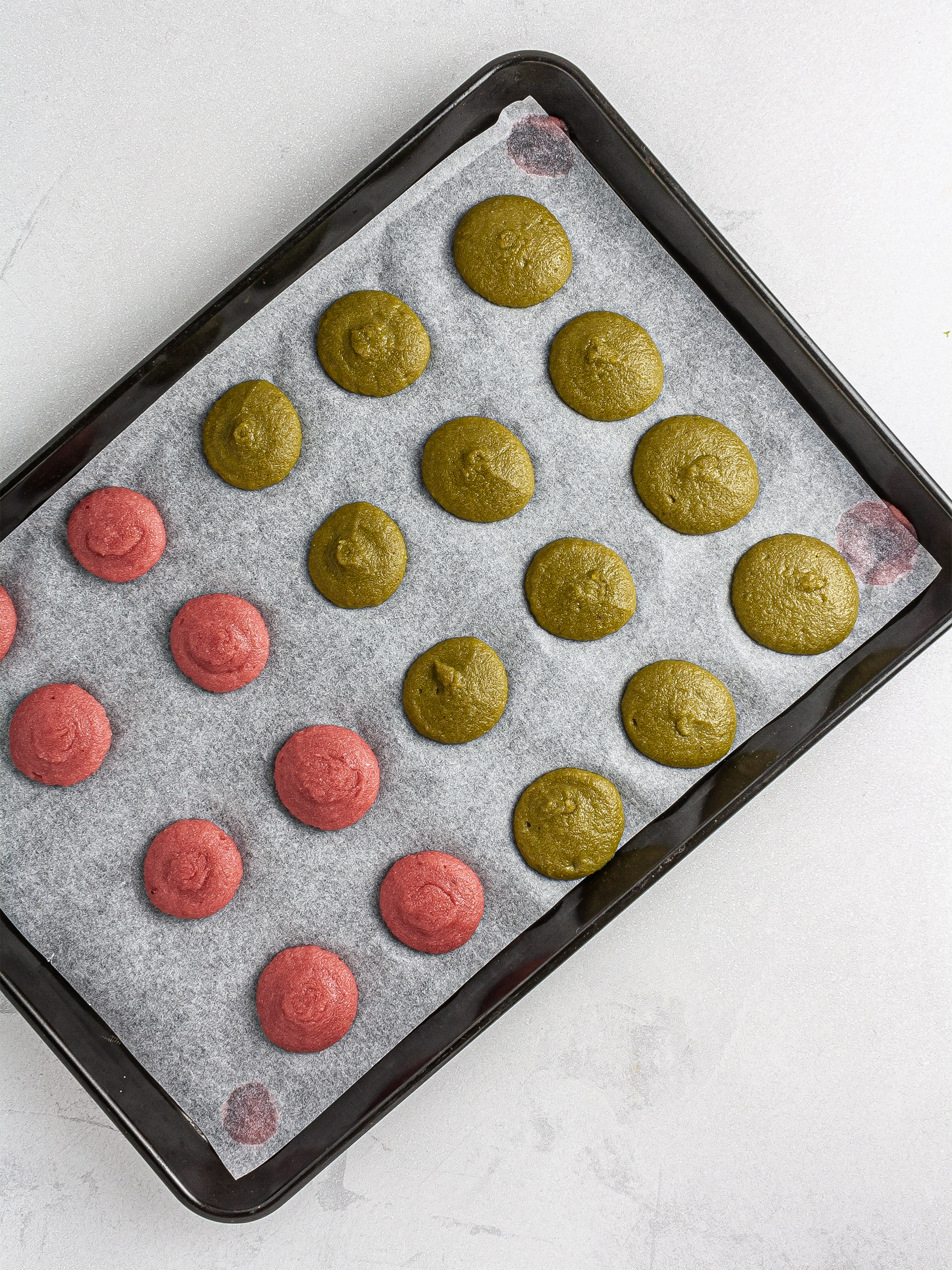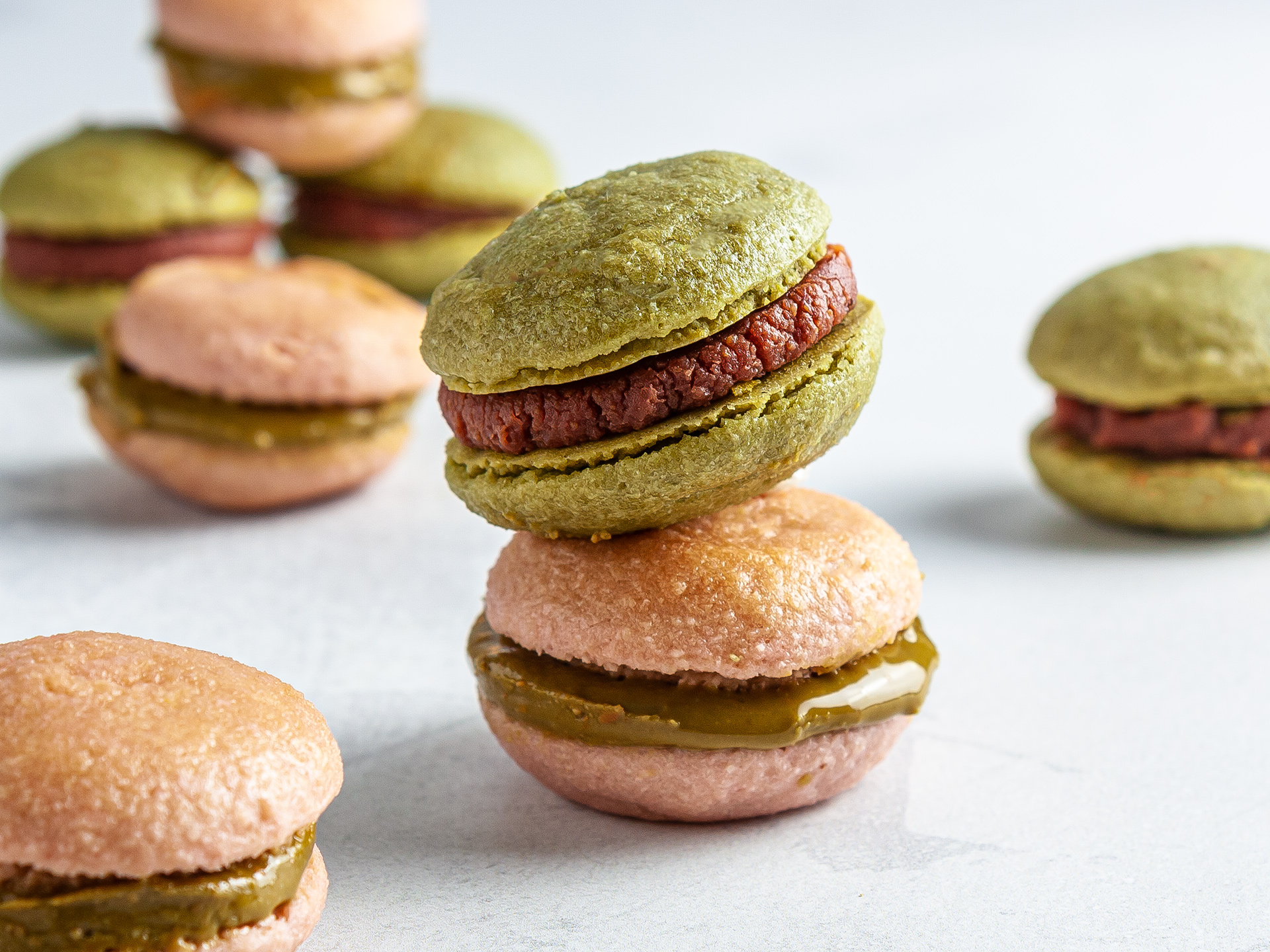If you are throwing a garden party, inviting people for tea, or trying to impress your work colleagues, there's nothing that packs the same wow-factor as macarons.
But classic macarons are not vegan and are loaded with sugars. To make sure everyone can enjoy your tiny bakes, we will show you how to make vegan macarons that are dairy-free, egg-free, and sugar-free.
The secret to making vegan macarons is likely sitting in your shelf, keeping your chickpeas afloat in their cans. That's right, the water released by the chickpeas - known as aquafaba - can replace whipped egg whites in vegan recipes.
Our macarons are also suitable for people on a weight-loss diet, keto diet, or that have diabetes. We will prepare them using no sugars at all, with the zero-carb sweetener erythritol. This magical ingredient delivers 70% of the sweetness of white sugars, but it's not absorbed by your body at all. So no carbs and no sugars get into your system. So far, science gave a big thumbs up to erythritol[1], and that's why we use it in many of our low-sugar recipes.
Moreover, instead of using unhealthy fillings like buttercream, we have resorted to cashew butter. You can prepare this yourself by just blitzing some cashew nuts or buy it ready-made in a store. Cashew butter will give you lots of vitamins, minerals, and has 85% less saturated fats than butter.
Finally, to give the macarons colour, we won't use any artificial compounds. Instead, we will use naturally colourful foods like matcha powder and beetroot juice. Thee ingredients will contribute wholesome nutrients to the recipe, making it even healthier.
Check out the nutritional profile for these little cuties, and you won't believe you are eating a sweet! Compared to the traditional ones, our plant-based macarons have zero sugars and half the saturated fats.
NOTE: The default ingredients yield 16 macarons and one serving consists of 2 macarons.
Are macarons gluten-free?
Yes, macarons are gluten-free because they use almond flour instead of wheat flours. So there's nothing special to do to make this recipe suitable for people with gluten intolerance.
Are macarons keto?
Classic macarons are not keto, because they use sugars both in the shells and in the buttercream filling. Our macarons are keto though, as we have used zero-carb sweetener erythritol for the shells, and haven't used any sugars in our cashew cream filling.
Our macarons also have the right amount of healthy fats, which are essential in a keto diet. These come from the almond flour and the cashew nut butter.
Overall, the ratio of fats to carbs in our recipe is ideal for a keto diet, with 0.7 g of sugars, 7 g of fat, and 1g of saturated fats in each macaron.
Can macarons be kept overnight?
Just like meringue, macarons hate moisture. A happy macaron is a dry macaron. Remember that!
Ideally, you would eat macarons on the same day. But if you made a big batch, or had some party leftovers, you can extend their lifespan by placing them in an air-tight container.
Now that they are sealed away from moisture and oxygen, you need to choose where to store them. If you foresee eating them within the next 24 hours (i.e. in the morning), then you may keep them on the counter. Otherwise, place them in the fridge for up to 4 days. Because or macarons are vegan, they last longer than those made with eggs.
Remember to minimize the number of times you open and close the container, to prevent air and moisture from seeping in. Ideally, put each portion of macarons into a separate box, and finish them once opened.
Are macarons like meringue?
The shell of macarons and the meringue share many ingredients, but not all. So the flavour and consistency between the two are different.
Both classic recipes use whipped egg whites, white sugar, and something acidic like creme of tartar. But macarons also contain almond flour, which gives them a nuttier flavour and a denser consistency.
Both vegan macarons and meringue replace the egg whites with aquafaba.
Whether you are going for the classic or vegan recipes, we suggest you follow our instructions above and make sugar-free macarons. These treats may look cute, but they are loaded with unhealthy white sugars. We made our macarons without any sugars, by using natural sweetener erythritol. So you can truly enjoy them without a worry in the world!
Ingredients
| Filling | |
| Cashew Butter | 70 g |
| Macaron | |
| Aquafaba (chickpeas brine water) | 280 mL |
| Erythritol | 330 g |
| Almond Flour | 150 g |
| Salt | 1 pinch |
| Cream of Tartar | 1 pinch |
| Natural Colorants | |
| Beetroot Juice | 4 tsp |
| Matcha Powder | 4 tsp |
Step 1
Add the aquafaba to a pot and simmer for 10 minutes or until reduced to half of the starting volume. So, if using the default ingredients, you have to bring it to down to 140ml.
To do so, you might need to check the volume a few times in between cooking time. Then, transfer into a clean bowl and refrigerate for a few hours or ideally overnight.
The prepared aquafaba should look brownish, dense, and slightly jelly-like.
Meanwhile, pulse the almond meal with half of the erythritol in a food processor to break down any lumps and mix the ingredients evenly.

Step 2
Whisk the chilled aquafaba into firm peaks as you would beat egg whites. Add salt and the cream of tartar to help the whipping process.
Then, add the remaining half of erythritol a few spoons at a time, and beat again until you have a thick and glossy meringue.
At this point, you can add your preferred colours. Here, we have added 1 tsp of matcha powder to half of the beaten aquafaba and 1 tsp of beetroot juice to the other half.

Step 3
Now, incorporate the beaten aquafaba a bit at a time into the almond mix.
The macaron batter should be thick, and when dropped from a spoon, it should fall in a continuous streak, without breaking.

Step 4
Transfer the macaron batter to a piping bag fitted with a round nozzle and pipe onto a silicon mat or baking tray lined with parchment paper forming 3 cm (1 inch) rounds.
Then, slam the tray down on your kitchen counter to remove any air bubbles that might be trapped int the batter.
Leave the macaron shell to rest at room temperature for 30 minutes or until the surface is dry enough not to stick to your fingertips when poked.

Step 5
Bake the macarons for 15 minutes at 150°C (300°F) for static ovens or at 130°C (260°F) for fan ovens.
Allow to cool down completely before peeling the macaron shells off from the baking paper or silicone mat.
Meanwhile, combine the cashew butter with 1 tsp of matcha for a green filling or with 1 tsp of beetroot juice for a reddish frosting.
Spread the cashew filling over one shell, cover with another shell, and lightly press down to secure the sandwich.

Tips
Don't worry if your piped macaron shells have "nipples", the will flatten down when baked.
